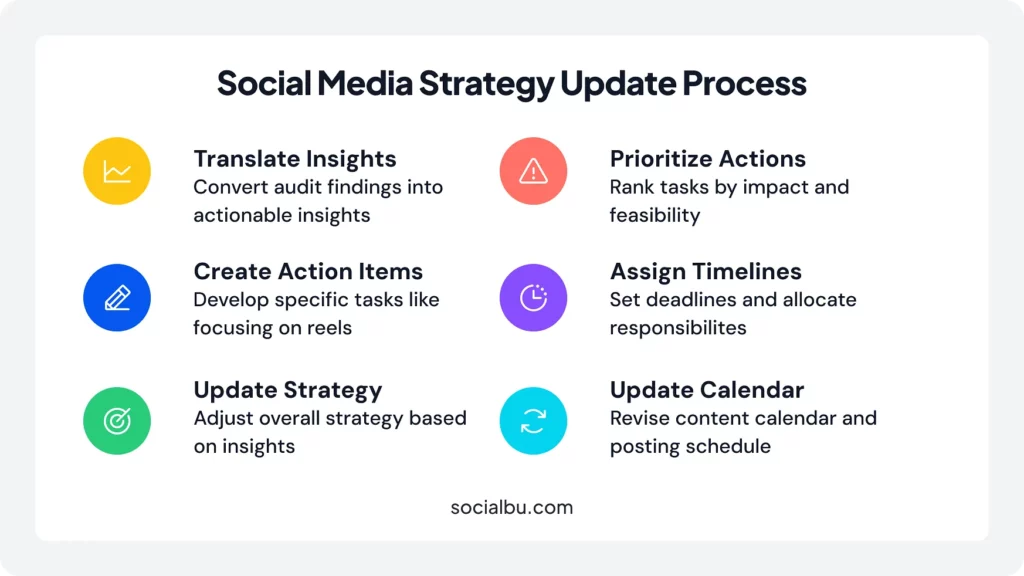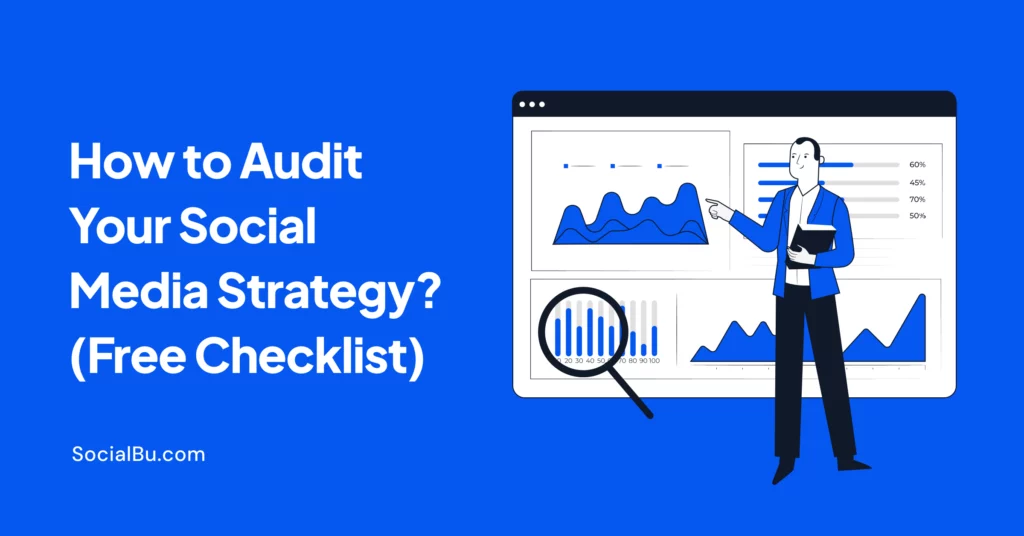Managing multiple clients at a small agency can feel like juggling too many balls at once. Without a streamlined client management workflow, agencies risk missed deadlines, frustrated clients, and burned-out teams.
Between content planning, scheduling posts for different time zones, responding to client feedback, and delivering timely reports, the workload piles up quickly.
Add in last-minute changes, platform updates, and urgent campaign requests, and it’s easy for even the most organized teams to feel overwhelmed.
That’s why having a clear, efficient workflow is essential, not just to keep up, but to succeed. The right tools and systems can help you stay organized and ensure every client request is met.
This blog shares five actionable workflow hacks for agencies to save time, boost productivity, and keep clients satisfied.
What is a Social Media Audit?
A social media audit is a structured, data-driven review of all your social channels, content, audience, and outcomes. Think of it as a social media account audit across every profile you own, plus any rogue or legacy handles you should reclaim or retire.
The goal is to measure what’s working, fix what isn’t, and align your social media strategy to business outcomes.
Why is a Social Media Audit Important?
Social media algorithms change frequently, and competition is tougher than before; ignoring your social media health can lead to wasted resources and missed opportunities.
That said, a well-executed process for auditing social media accounts can boost ROI by identifying underperforming content, revealing audience preferences, and highlighting growth areas.
For instance, businesses that conduct regular audits see up to 20% higher engagement rates, according to industry reports.
Key Components of a Social Media Audit
So, before we jump into the process of social media audit, let’s outline the core elements of a social media audit.
These components form the foundation for any effective review:
- Inventory of Accounts: List all your social media profiles, including usernames, URLs, and ownership details.
- Performance Metrics: Track likes, shares, comments, reach, and impressions.
- Content Analysis: Evaluate post types, frequency, and themes for content performance analysis.
- Audience Insights: Examine demographics, growth trends, and follower growth tracking.
- Competitor Benchmarking: Include competitor social media analysis to see how you stack up.
How to Perform a Step-by-Step Guide to Auditing Your Social Media Strategy
Conducting a social media audit doesn’t have to be complicated. Follow this step-by-step guide to review and refine your approach systematically.
1. Define Goals and KPIs

The first step in any social media strategy audit is clarifying what success looks like. Without clear goals, your audit lacks direction. Begin by revisiting your business objectives, whether it’s increasing brand awareness, driving website traffic, or generating leads.
Translate them into specific, measurable social media KPIs like engagement rate, click-through rate, or conversion metrics.
Once goals are set, benchmark your current performance against them. This sets the stage for the rest of the audit.
- Identify primary objectives
- Select relevant KPIs (e.g., track monthly active users or ROI from ads).
- Align with the overall marketing strategy to ensure cohesion.
2. Evaluate Content Performance
Content is the heart of social media, so assessing its impact is key in a social media performance audit. Review past posts to see which formats, videos, images, and stories resonate most. Use content performance analysis to spot trends, like high-engagement topics or optimal posting times.
Analyze metrics such as views, shares, and saves to identify top performers. This helps refine your content calendar for better results.
- Categorize content by type (e.g., educational, promotional, user-generated).
- Calculate average performance per post (e.g., engagement per 1,000 followers).
- Identify patterns in underperforming content (e.g., low-res images or off-brand messaging).
3. Analyze Platform-by-Platform Performance

Not all platforms are equal. Platforms like Instagram excel in visuals, while LinkedIn is better suited for B2B networking. In this phase of the social media account audit, break down data by platform to uncover strengths and weaknesses.
Examine metrics like reach and impressions specific to each site. This reveals if you’re over-investing in underperforming channels.
- Review audience overlap across platforms.
- Assess posting frequency and consistency.
- Evaluate ad performance if applicable.
4. Assess Audience Growth and Demographics
Understanding your audience is vital for targeted strategies. During a social media marketing audit, track follower growth over time and analyze demographics like age, location, and interests.
This step highlights shifts in your audience, helping you tailor content accordingly.
- Monitor net follower gain/loss monthly.
- Use platform insights for demographic breakdowns.
- Identify key segments
5. Track Engagement Metrics

Engagement is a direct indicator of content resonance. To calculate engagement rates, calculate rates and track trends.
High engagement signals strong community building, while low rates may indicate irrelevant content.
- Break down by type (likes, comments, shares).
- Identify peak engagement times.
- Analyze sentiment in comments for qualitative insights.
6. Perform a SWOT Analysis
A SWOT (Strengths, Weaknesses, Opportunities, Threats) analysis pulls together all your key findings. This intuitive strategy in a social media audit helps visualize internal and external factors.
Strengths might include viral content, while threats could be algorithm changes.
- List strengths (e.g., high video engagement).
- Pinpoint weaknesses (e.g., inconsistent posting).
- Explore opportunities (e.g., untapped platforms).
7. Develop Action Items and Update Strategy

Finally, translate insights into a roadmap. Create actionable items, such as “Revamp Instagram content to focus on reels,” and update your overall strategy. Prioritize quick wins while planning long-term changes.
This ensures your social media audit leads to tangible improvements, like refined social media KPIs or budget reallocations.
- Prioritize actions based on impact and feasibility.
- Assign timelines and responsible team members.
- Update your content calendar and posting schedule.
Social Media Audit Checklist
To make your social media audit checklist foolproof, use this printable guide:
- ✅ List all accounts and verify ownership.
- ✅ Gather 3-6 months of data on KPIs.
- ✅ Analyze content types and performance.
- ✅ Review audience demographics and growth.
- ✅ Calculate engagement rates per platform.
- ✅ Conduct a SWOT analysis.
- ✅ Benchmark against competitors.
- ✅ Document findings in a report.
- ✅ Develop 5-10 action items.
- ✅ Update strategy and set review date.
This checklist ensures nothing slips through the cracks during your audit of social media accounts.
Social Media Strategy Audit Sheet
Here’s an easy-to-follow and actionable social media strategy audit sheet to get you started straight away.
| Channel | Goal | KPIs | Current Baseline | Key Insights | Action Items | Owner | Due Date |
|---|---|---|---|---|---|---|---|
| Drive saves and website clicks | Saves, ER by reach, Link clicks | ER 4.2%, Saves avg 120 | Reels with “how-to” outperform by 2.1x | Increase reels; add mid-caption CTAs; test new hook styles | Jane | Oct 15 | |
| Demand gen | CTR, Leads, Comments | CTR 1.1%, 12 MQLs | Carousel posts drive best CTR | Post 3 carousels/week; add UTM to every link | Aamir | Oct 20 | |
| TikTok | Awareness | Views, Watch time, Shares | Avg watch time 4.8s | Short, punchy edits win | Test 7–12s edits; add subtitles & hook in 2s | Mei | Oct 30 |
Tools to Simplify Social Media Audit
Auditing manually can be time-consuming, so leverage tools for efficiency. Here are top recommendations:
1. SocialBu
As a comprehensive AI social media management tool, SocialBu makes auditing effortless. It offers built-in analytics, smart scheduling, automating social media replies across multiple accounts, and much more.
Here’s how SocialBu streamlines your audit process:
- Centralized analytics: Track key metrics across profiles and platforms in a single dashboard for rapid platform analytics and reporting.
- Smart Scheduling: Plan your post‑audit social calendar with a visual planner, queues, and time slots. Tailor copy per platform, schedule first comments where supported, and use bulk scheduling to roll out your updated cadence quickly.
- True Automation: Reduce manual work with evergreen queues, automate replies, and simple rules to route tasks. Turn your audit insights into repeatable workflows that maintain high quality and minimize effort.
- Team collaboration: Invite teammates with role-based permissions, route posts for review and approval, assign tasks, and leave internal notes. Maintain an audit trail to track changes, decisions, and results easily.
2. Google Analytics
For deeper traffic insights, Google Analytics integrates with social platforms to track referrals, conversions, and user behavior.
- Track social-driven sessions, engagement, conversions, and revenue.
- Use UTM parameters to attribute performance by platform, post, and campaign.
- Build explorations to compare paid vs. organic social and assisted conversions.
3. BuzzSumo
BuzzSumo excels in competitor social media analysis and content discovery. Search for trending topics, analyze shares, and identify top-performing content to inform your audit.
- Research top-performing content by topic and platform.
- Analyze competitors’ best posts to inform your competitor’s social media analysis.
- Identify influencers/creators and trending angles to fuel your content strategy.
Wrap-Up
A social media audit isn’t just extra work; it’s your game plan for smarter growth. It clarifies what moves the needle, reveals where you’re overspending time or budget, and ties every post back to measurable outcomes
When you run a social media performance audit with discipline, your best opportunities usually come from patterns already hiding in your data.
Before you pick up new tactics, commit to better decisions. Decide the role of each platform, set clear social media KPIs, and use your social media audit checklist to focus on actions that improve reach quality, engagement depth, and conversion efficiency.
Sign up for SocialBu now to centralize analytics and reporting, streamline scheduling and engagement, and turn your audit into measurable growth.
Recommended Readings:
- How are Content Creators Earning 5–6 Figures with Content in 2025
- What is a Great Content Marketing Plan That Works Everytime
- 20+ Social Media KPIs to Track for Brand Success
FAQs
How to run the easiest social media audit?
The easiest way is to use a social media audit template from tools like SocialBu, focusing on key metrics like engagement and growth over the last quarter.
What is the primary goal of a social media audit?
The primary goal is to evaluate and optimize your strategy for better alignment with business objectives and improved performance.
What best describes a social media audit?
A social media audit is a detailed review of your social accounts, content performance, and engagement metrics to identify strengths, weaknesses, and opportunities for improvement.
What is the concept of social audit?
A social audit generally assesses a company’s social responsibility and ethical practices. In the context of media, it focuses on evaluating platform performance, audience engagement, and strategy effectiveness.
Who performs a social audit?
Social media audits can be conducted by marketing teams, digital agencies, social media managers, or even individuals managing their own online presence and brand identity.
How to do an audit on social media?
To perform a social media audit, follow a step-by-step approach: define your goals, gather performance data, analyze metrics, identify gaps, and update your strategy using analytics tools.
What is the point of a social media audit?
The main purpose of a social media audit is to uncover actionable insights that lead to growth, increased efficiency, better audience engagement, and higher return on investment (ROI).
How to conduct a social audit?
Conducting a social audit involves collecting data from all accounts, performing detailed analysis such as SWOT, identifying trends, and creating strategic action plans to improve results.
When conducting a social media audit, the first step is?
The very first step is to define your goals and key performance indicators (KPIs), setting a clear benchmark for measuring success and guiding your evaluation process.
How do I audit my Instagram?
To audit your Instagram, use Instagram Insights to review metrics like reach, engagement, and follower growth, then compare the results with your overall content strategy and goals.
How to create a social media strategy?
Creating a social media strategy starts with setting clear goals, researching your target audience, planning relevant content, scheduling posts, and auditing regularly to refine your approach.







